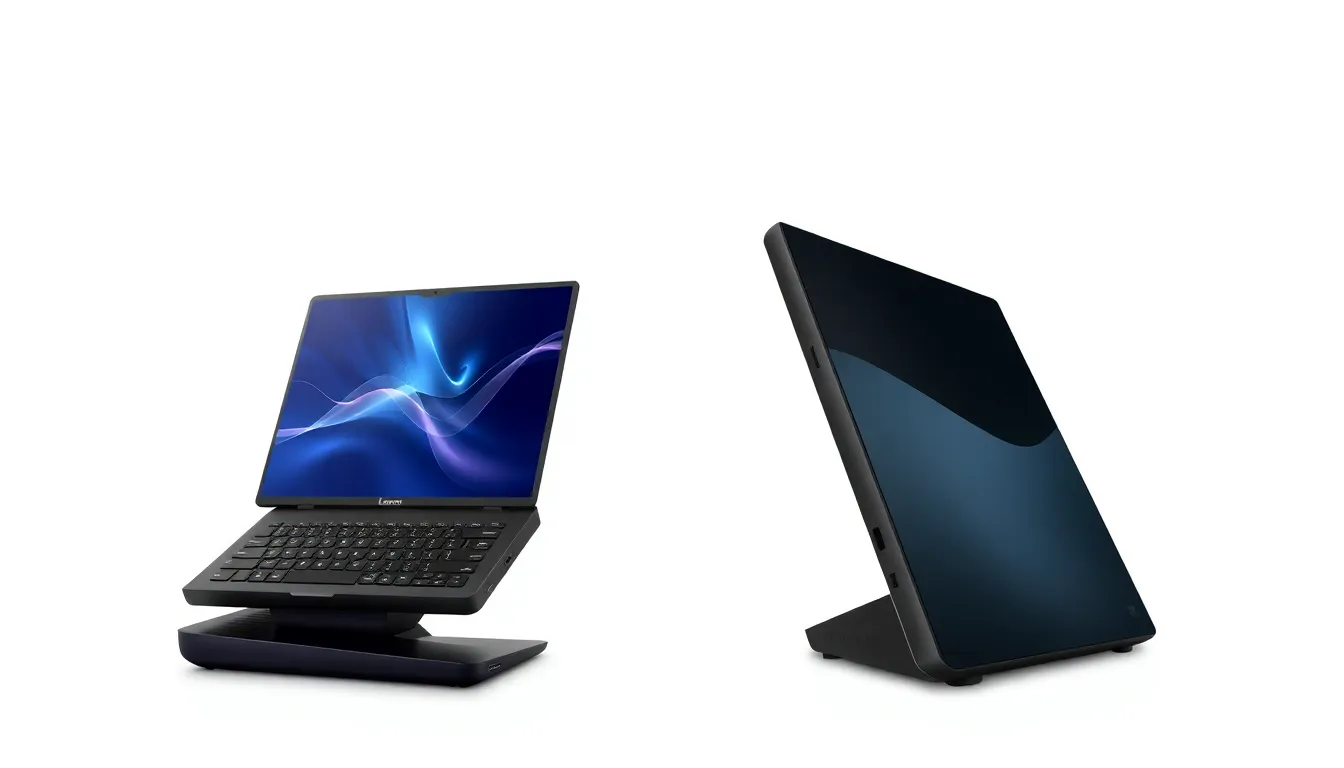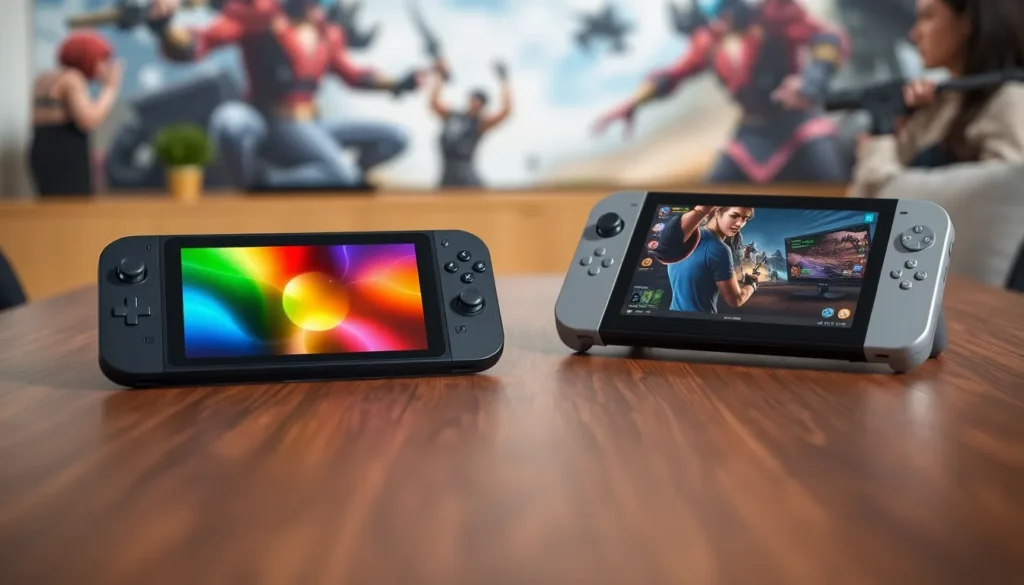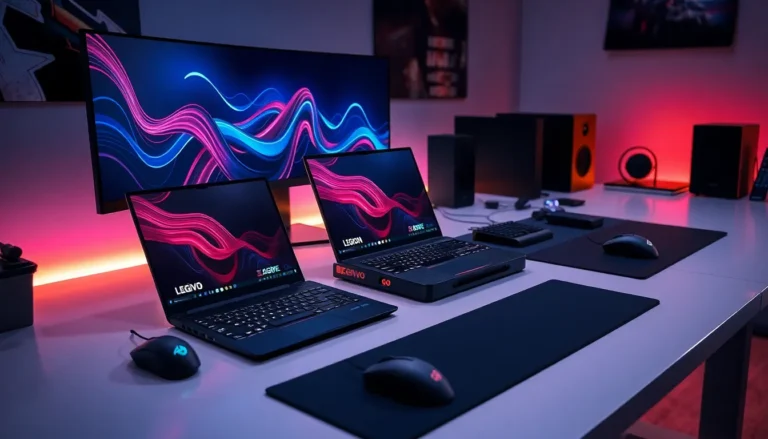In the battle of handheld gaming powerhouses, the Steam Deck and Lenovo Legion Go are ready to duke it out. Both devices promise to deliver epic gaming experiences, but which one truly reigns supreme? Picture this: one’s a portable powerhouse that lets you take your entire game library on the go, while the other boasts cutting-edge specs that could make a gaming PC blush.
As gamers weigh their options, the stakes are high. Should they choose the Steam Deck for its versatility or the Lenovo Legion Go for its raw performance? The decision might feel like picking between pizza and tacos—both are delicious, but only one can satisfy that specific craving. Let’s dive into the nitty-gritty and find out which handheld champion deserves a spot in your gaming arsenal.
Table of Contents
ToggleOverview of Steam Deck and Lenovo Legion Go
Steam Deck combines powerful hardware with a portable design, allowing gamers to enjoy a wide array of titles from the Steam library. It features a custom APU developed by AMD, with a quad-core processor and a GPU capable of handling modern gaming demands. Users appreciate the extensive compatibility with both PC games and emulators, enhancing the versatility of the device.
On the other hand, Lenovo Legion Go targets gamers seeking high-end performance in a handheld format. It includes advanced specifications like a high-refresh-rate display and a robust AMD Ryzen Z1 chip, providing seamless gameplay experiences. The device also supports advanced features such as ray tracing and superior graphics performance, making it an attractive option for gamers focused on visual fidelity.
Portability greatly influences user choices between the two devices. Steam Deck emphasizes accessibility, featuring a lightweight design and robust battery life, which appeal to gamers on the move. Lenovo Legion Go, while slightly bulkier, prioritizes performance, with a focus on extensive gaming sessions without compromising power.
Both devices offer unique game libraries and user interfaces, catering to distinct preferences. Steam Deck’s integration with Steam services enhances its library access, while Lenovo Legion Go introduces the Legion software suite, optimizing performance and game management.
Gamers must assess personal preferences and gaming styles when choosing between the Steam Deck and Lenovo Legion Go. Features like ergonomics, display quality, and battery life play crucial roles in determining which device aligns with their gaming needs.
Key Specifications Comparison

A direct comparison of the Steam Deck and Lenovo Legion Go reveals important specifications that impact user experience.
Design and Build Quality
Weight considerations favor the Steam Deck, weighing around 1.47 pounds, which enhances portability. Build quality remains robust, with a sturdy plastic shell that can withstand daily use. In contrast, the Lenovo Legion Go weighs approximately 1.65 pounds, a slight increase that provides a more premium feel. Its aluminum chassis improves durability, making it suitable for long-term ownership. Both devices offer ergonomic designs, but the Steam Deck features contoured grips enhancing comfort during extended play. Meanwhile, the Legion Go integrates additional cooling vents to maintain performance even during intense gaming sessions.
Performance and Hardware
The Steam Deck features a custom AMD APU, combining a quad-core Zen 2 CPU and RDNA 2 GPU, ensuring fluid gaming across various titles. This hardware supports 1280 x 800 resolution with a 60 Hz refresh rate, offering solid performance. Conversely, the Lenovo Legion Go utilizes the AMD Ryzen Z1 chip, providing superior processing power and enhanced graphics capabilities. Capable of supporting ray tracing, its 2560 x 1600 display reaches refresh rates of up to 144 Hz, delivering a truly immersive experience. Both devices come with comparable RAM options, but the higher performance of the Legion Go sets it apart for demanding games.
Gaming Experience
The gaming experience varies significantly between the Steam Deck and Lenovo Legion Go, accommodating different player preferences and styles.
Graphics and Display
Steam Deck features a 1280 x 800 resolution display with a 60 Hz refresh rate, delivering respectable visuals for most titles. Conversely, Lenovo Legion Go stands out with a 2560 x 1600 resolution and refresh rates reaching 144 Hz. This difference translates into sharper images and smoother gameplay for demanding titles. Ray tracing support on Lenovo also enhances graphical fidelity, making environments more immersive. Gamers benefit from the high-quality visuals of Lenovo while still enjoying a decent performance on Steam Deck. Both devices provide vibrant colors, but Lenovo’s display offers a superior experience for graphic-intensive gameplay.
Controls and Comfort
Steam Deck’s design prioritizes ergonomics with a comfortable grip, making extended gaming sessions more enjoyable. Unique button layout on the device caters to diverse gaming styles, ensuring accessibility for various genres. In contrast, Lenovo Legion Go incorporates responsive controls alongside a more compact form factor. The premium materials enhance the feel during gameplay, promoting comfort during longer sessions. Both devices include adjustable features, allowing gamers to tailor their setups for optimal engagement. Overall, each handheld offers its approach to comfort and control, appealing to different player needs and preferences.
Battery Life and Portability
Battery life significantly impacts user experience in handheld gaming devices. The Steam Deck offers up to 7 hours of gameplay, depending on usage, making it highly portable for gaming on the go. Weighing approximately 1.47 pounds, it remains light enough for extended play without causing fatigue. Its robust design includes a plastic shell, ensuring durability while maintaining ease of transport.
In contrast, the Lenovo Legion Go stands at around 1.65 pounds. Despite its slightly bulkier frame, it emphasizes longer gaming sessions with its energy-efficient components. Users can expect around 4 to 5 hours of battery life during intensive gaming, balancing power with performance. The premium aluminum chassis also supports better heat management, contributing to overall device longevity.
Portability extends beyond weight; size and design play crucial roles. Both devices feature control layouts that enhance user comfort. Steam Deck boasts an ergonomic design, allowing users to grip it comfortably during lengthy sessions. Likewise, the Lenovo Legion Go uses quality materials that enhance tactile feedback, providing an enjoyable gaming experience.
Gamers focused on convenience and extended usage benefit from the Steam Deck’s optimized battery and lightweight design. Those prioritizing high performance might lean toward the Lenovo Legion Go, despite its lesser battery life. Each device caters to specific needs, allowing users to choose based on their gaming habits and portability requirements.
Price and Value for Money
Evaluating the price and value for money of the Steam Deck and Lenovo Legion Go reveals important considerations for potential buyers. The Steam Deck starts at approximately $399 for the base model with 64 GB of eMMC storage. Additional pricing tiers exist, including a 256 GB NVMe SSD version priced at $529 and a 512 GB NVMe SSD model costing around $649. Gamers benefit from this pricing structure, especially given the Steam Deck’s access to an extensive library of PC games and emulators.
On the other hand, the Lenovo Legion Go holds a higher price tag, beginning at around $699 for the base model featuring 512 GB of storage. The robust AMD Ryzen Z1 processor justifies some of this increased cost by offering advanced features like ray tracing and better graphics performance. Buyers seeking enhanced performance may find the additional investment worthwhile when considering long gaming sessions.
In terms of value, the Steam Deck excels with its competitive pricing and versatility, catering to those who prioritize portability and accessibility. Users gaining access to a vast library of games at a lower initial cost often find it offers excellent value for money. Comparatively, the Lenovo Legion Go appeals to gamers who desire high-end performance and are willing to pay a premium for superior graphics and a higher resolution display.
Overall, both devices offer distinct value depending on user preferences and gaming styles. Those seeking budget-friendly options with decent performance lean towards the Steam Deck, while gamers prioritizing high performance benefit from the Lenovo Legion Go’s premium features.
Choosing between the Steam Deck and the Lenovo Legion Go ultimately comes down to individual gaming preferences and priorities. The Steam Deck excels in portability and versatility making it perfect for gamers on the move. Its access to a vast library of titles combined with a lightweight design makes it a compelling choice for casual gaming.
On the other hand the Lenovo Legion Go caters to those who prioritize high-end performance and stunning visuals. With its advanced graphics capabilities and premium build quality it appeals to serious gamers looking for an immersive experience.
Both devices offer unique strengths ensuring there’s a suitable option for different gaming styles. Whether one values portability or performance the right choice will enhance their gaming journey.










